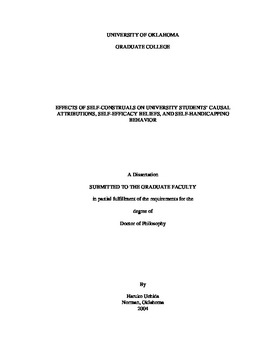| dc.contributor.advisor | DeBacker, Teresa K., | en_US |
| dc.contributor.author | Uchida, Haruko. | en_US |
| dc.date.accessioned | 2013-08-16T12:19:34Z | |
| dc.date.available | 2013-08-16T12:19:34Z | |
| dc.date.issued | 2004 | en_US |
| dc.identifier.uri | https://hdl.handle.net/11244/810 | |
| dc.description.abstract | Participants were administered the Self-Construal Scale (Singelis, 1994), the Implicit Theory Measure (Dweck & Henderson, 1989), the Patterns of Adaptive Learning Survey (Midgley et al., 2000), the subject-specific self-efficacy scale used in Bong's (2000) research, the Revised Causal Dimension Scale (McAuley, Duncan, & Russell, 1992), and measures of perceived importance of pervasive causal factors and confidence developed by the research. | en_US |
| dc.description.abstract | The primary purpose of the present study was to examine the applicability of the model and Singelis' argument by investigating individuals in the same cultural setting (United States). In particular, the present study explored the relationships between each self-construal and the following psychological constructs: causal attribution patterns, levels of self-efficacy and confidence, implicit theory of ability, and use of self-handicapping strategies. In addition, the present study was aimed at examining associations between level of self-efficacy and causal attributions, and confirming the predictive power of self-efficacy for academic achievement. | en_US |
| dc.description.abstract | Markus and Kitayama (1991) have presented a self-construal model and identified two types of self-images held by individuals in individualistic and collectivistic cultures. The model proposes that individualists tend to have self-images that emphasize the uniqueness of the individual (independent self-construal), while collectivists tend to have self-images that emphasize connectedness with others (interdependent self-construal). Furthermore, the model illustrates how these two types of self-images differently reflect on cognition, emotion, and motivation. Arguing that the two types of self-images coexist within an individual, Singelis (1994) has extended the model to apply to interpret variations in psychological patterns demonstrated by individuals in the same type of cultures. | en_US |
| dc.description.abstract | The results showed that individuals who scored higher on the independent self-construal measure demonstrated self-enhancement in some of the attribution patterns, while those who scored higher on the interdependent self-construal measure did not exhibit self-enhancement in regard to the corresponding attributions. Additionally, the latter exhibited lower self-efficacy compared to the former. These findings supported the model and Singelis' argument by demonstrating variations in causal attributions and self-efficacy as related to individual differences in the level of each self-construal. However, some findings were inconsistent with the self-construal theory, and thus indicate a need to re-examine the model. | en_US |
| dc.format.extent | xii, 129 leaves ; | en_US |
| dc.subject | Self-efficacy. | en_US |
| dc.subject | Self-perception. | en_US |
| dc.subject | College students Psychology. | en_US |
| dc.subject | Education, Educational Psychology. | en_US |
| dc.title | Effects of self-construals on university students' causal attributions, self-efficacy beliefs, and self-handicapping behavior. | en_US |
| dc.type | Thesis | en_US |
| dc.thesis.degree | Ph.D. | en_US |
| dc.thesis.degreeDiscipline | Department of Educational Psychology | en_US |
| dc.note | Source: Dissertation Abstracts International, Volume: 65-10, Section: A, page: 3697. | en_US |
| dc.note | Adviser: Teresa K. DeBacker. | en_US |
| ou.identifier | (UMI)AAI3150964 | en_US |
| ou.group | Jeannine Rainbolt College of Education::Department of Educational Psychology | |
